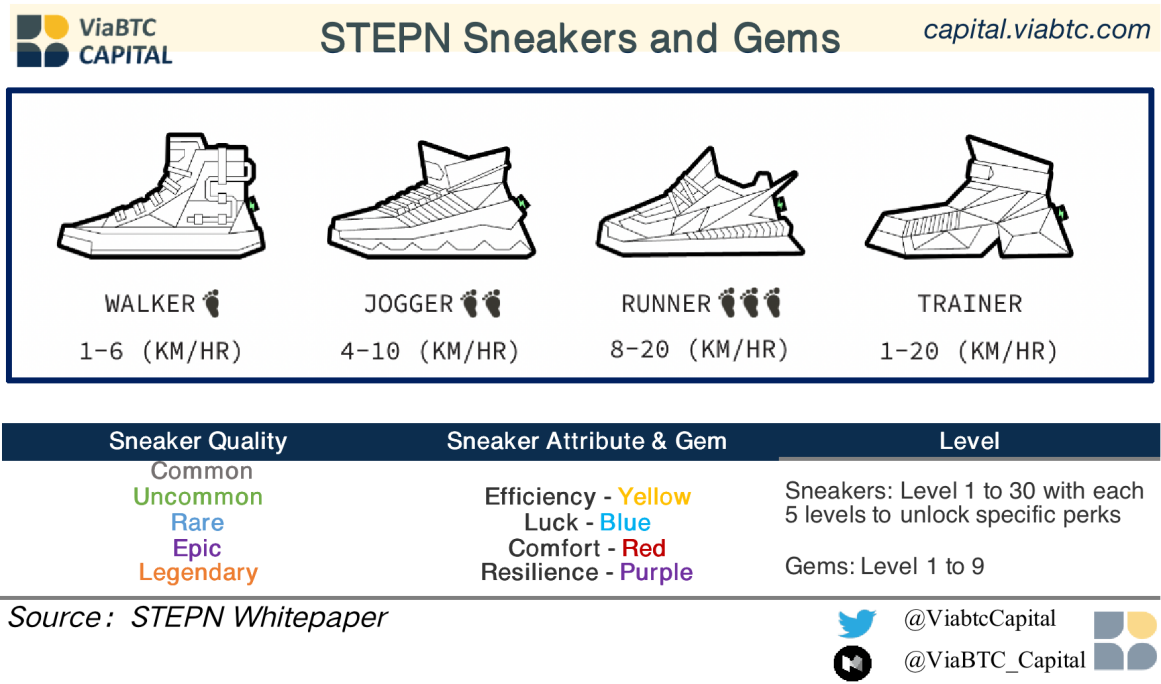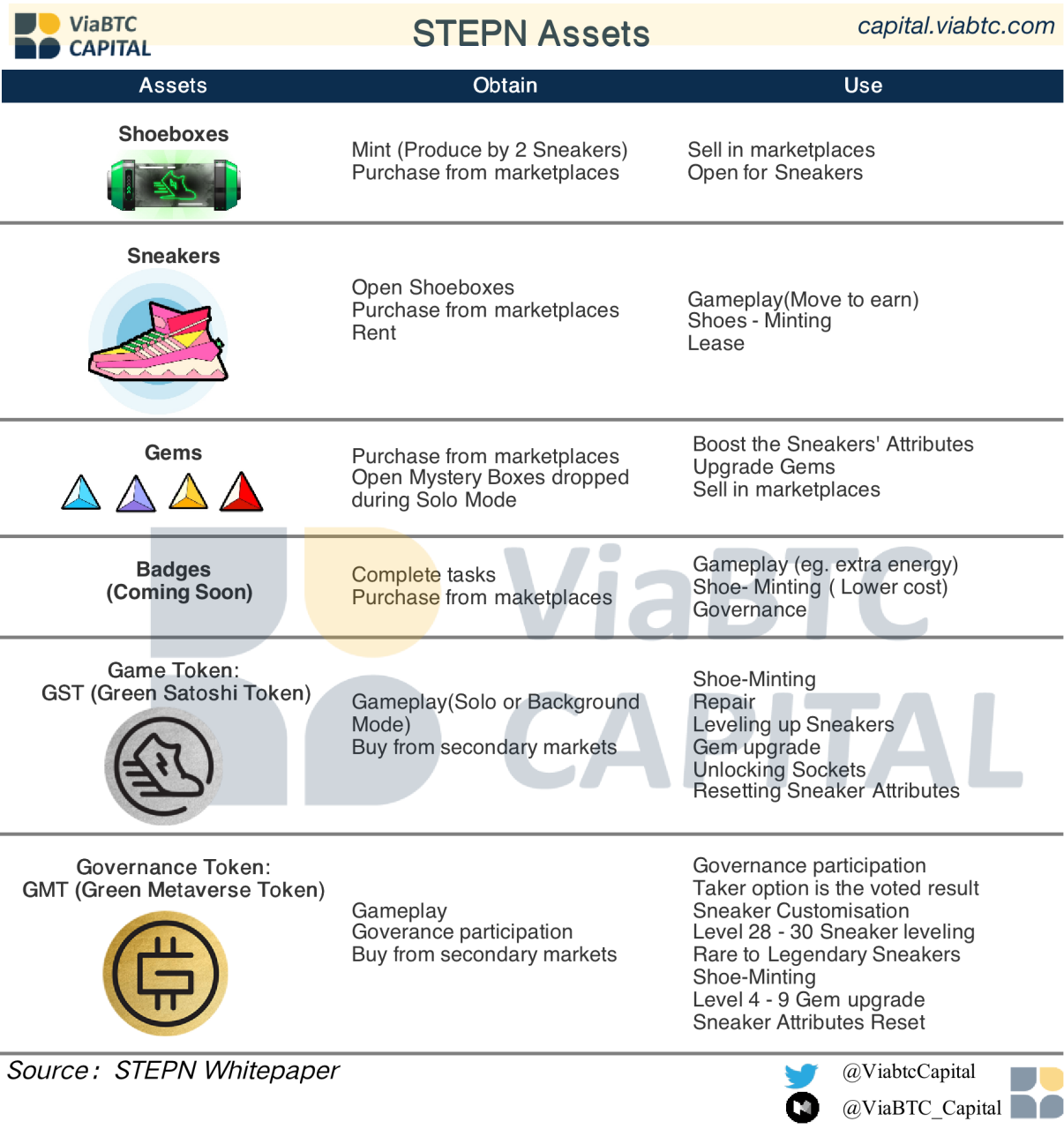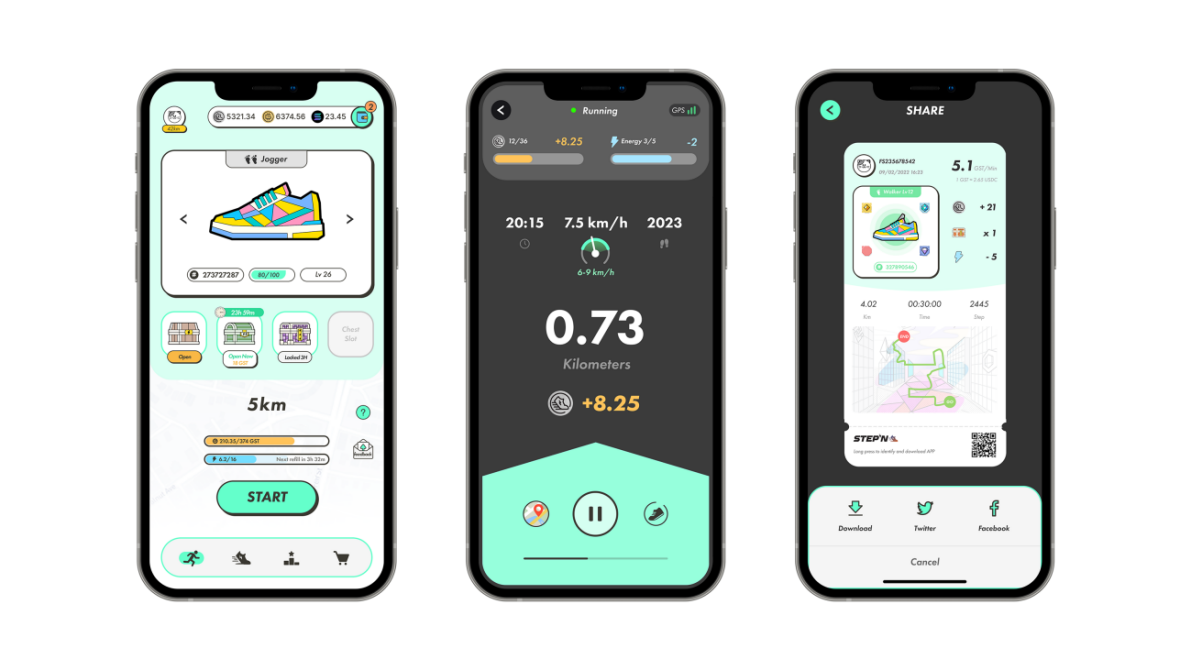ViaBTC Capital|STEPN: A Gamification Model for Web 3.0 Applications
On the Web 2.0 track, thousands of applications are competing fiercely, and it is increasingly difficult for newly developed projects to stand out. Only exciting and challenging projects can retain users. Therefore, in order to increase user stickiness and retention, most apps have implemented gamification strategies.
What if it was in the world of Web 3.0? Although Web 3.0 applications are not many, they still have to compete with Web 2.0 applications. Therefore, gamifying apps, a strategy known in the Web 3.0 era as "gamified finance" (GameFi), may be a good idea.
The STEPN project in ViaBTC Capital's portfolio is one such Web 3.0 application that takes full advantage of GameFi elements. This article will introduce the concept and design of STEPN, as well as the inspiration brought by the STEPN project.

What is STEPN?
STEPN is a Web3.0 life application based on the "Move2Earn" mechanism, with built-in gamified financial and social elements, currently running on the Solana blockchain. Here is some information about the Move2Earn mechanism:
l How to exercise? Forms of exercise include walking, jogging or running outdoors. Before starting to exercise, users need to download the STEPN mobile app, register an account, import or create a Solana wallet, and buy or transfer "NFT sneakers" (Sneaker NFT). Movement is ineffective without NFT sneakers.
l What can I earn? Through movement, users will acquire crypto assets such as game tokens and NFTs, which users can use or sell for profit. In addition, users can "earn health" because the Move2Earn mechanism motivates users to go outdoors; users can also "earn honors" to show off their achievements, such as showing badges earned for completing tasks and rewards earned through special tasks Special sneakers.
l How to earn more? It depends on the physical effort of the user and the effective strategy adopted. If users are willing to take the time to study this comprehensive and complex GameFi economic mechanism, they will be able to develop an appropriate strategy.
The following will also give you a basic understanding of STEPN's design.
How is STEPN designed?
1. Crypto Assets
As an app with GameFi elements, STEPN is designed to include both non-fungible tokens (NFT) and homogeneous tokens (FT). NFT includes shoebox (Shoebox), sneakers (Sneaker), gem (Gem) and badge (Badge), while FT includes game token GST (Green Satoshi Token) and governance token GMT (Green Metaverse Token).
Sneakers are the key NFT in the game, the equivalent of Axie. Since two sneakers can make another new sneaker, its "egg state" is a shoe box. From a design point of view, there are different types of sports shoes that can be easily distinguished, including walking shoes (Walker), jogging shoes (Jogger), fast running shoes (Runner) and all-round shoes (Trainer), different types of sports shoes The optimum speed required varies. Aside from the type, though, the quality of the sneakers also varies. The qualities of sneakers include Common, Uncommon, Rare, Epic and Legendary. The quality of shoes is different, and they have different levels of basic attributes, including efficiency (Efficiency), luck (Luck), comfort (Comfort) and elasticity (Resilience). When the sneakers are upgraded, the level of each attribute will also be improved, the highest level is 30, and every 5 levels will unlock additional rewards, such as the ability to unlock the socket (Socket).
Each sneaker has four slots, and one slot is unlocked when a sneaker reaches level 5, 10, 15, and 20. The slot is used to insert the corresponding gem, which is used to increase the attribute points of the sneaker. There are 4 types of gemstones: yellow for efficiency, blue for luck, red for comfort, and purple for elasticity. The maximum level of gems is 9, and it takes 3 gems to upgrade to the next level. Additionally, badges can provide additional rewards for gameplay, shoemaking, and governance.
All in all, the number, types, attributes and levels of the above NFTs will have a great impact on the user's income in the game, which will be further elaborated in the content of income factors.

There are two FTs in STEPN. One is GST, a game token similar to SLP, as a utility and reward token; the other is GMT, which is a governance token, similar to AXS.
GST can be issued unlimitedly. Players can mint GST in single player mode (Solo) or background mode (Background), and use scenarios such as manufacturing, repairing, upgrading sneakers, upgrading gems, unlocking slots, and resetting sneaker attributes need to consume GST.
The total amount of GMT is 6 billion, which can be minted in Token Generation Events (TGE). User participation in governance, upgrading sneakers from level 28 to level 30, casting rare, epic, and legendary level sneakers will consume GMT.
As a Move2Earn game, STEPN distributes 30% of the total GMT to users participating in Move2Earn and governance. A significant portion of the 30% of the Eco Fund will be used for giveaways and hosting community events, such as the Always On Marathon. STEPN was the first game to introduce a Bitcoin-like halving mechanism (STEPN was originally called Find Satoshi). The number of GMT minted is halved every three years, i.e. 15% of the total GMT supply will be earned in the first three years, 7.5% in the second year, and 3.25% in the third year until all tokens are released to extend the project life cycle.
The sources and uses of encrypted assets in STEPN can be seen in the figure below.

2. Game Mode
STEPN has three modes of operation: Solo, Marathon and Background. For ease of understanding, you can think of single player mode as PvE mode and marathon mode as PvP mode.
In single-player mode, users are rewarded for outdoor activities and energy consumption. Note that this energy is not physical energy, but a play element. If the energy is exhausted, there is no gain. Every 1 energy is earned by exercising for 5 minutes, and every 6 hours of exercise, the energy is replenished by 25% until the energy limit is reached. Users can earn GST/GMT for every minute of movement, and during the movement, mystery boxes will drop randomly. And the game's token revenue depends on 4 main factors: the type of sneakers, efficiency, comfort of the sneakers, and speed of movement.

In Marathon mode, players can earn tokens and badges if they win. STEPN has set up weekly marathons (choose to participate in 2.5km, 5km or 7.5km) and monthly marathon (choose to participate in 5km, 10km or 15km), but users can only participate in one kind of kilometers per week or month marathon. Users need to select the marathon option to register and pay at least 24 hours before the marathon starts, and the fee will be refunded after the marathon is completed. Competitors who fail to complete the marathon will have their fees added to the leaderboard rewards.
In the background mode, users can earn income even if they do not use STEPN. No energy expenditure is required, but the maximum number of steps per day is 3000.
3. Income factor
The profit in the marathon mode mainly depends on the user's running performance, while there are many factors that affect the user's profit in the single-player mode. Specifically, the single-player mode sets a daily energy cap and a daily token cap, limiting the maximum amount of energy and tokens a user can obtain per day. If users want to increase the energy limit and token limit, the method is to have more and higher quality sneakers, increase movement speed, upgrade sneakers (including type, attribute, quality and level), upgrade gems (including type, level) and slot quality) or add NFT badges. The following is the detailed data:

4. Other systems and infrastructure
In addition to the income cap and energy system mentioned above, STEPN also includes a quest system, an achievement system, an anti-cheating system, and a tax system. The first two systems are still under development, and the latter two have been deployed online.
The anti-cheat system consists of three mechanisms: GPS tracking, motion sensors and health data, and machine learning to detect cheating through data simulations. The system prevents players from cheating in the game, and the account of the cheater will be penalized.
STEPN also has a tax system that will charge different taxes and fees for various in-app activities (such as market transactions, shoemaking, and renting sneakers) at 2%, 4%, 6%, and 8%.
In addition, STEPN is an invitation-only game with an activation code system. The user spends 10 energy to get 1 activation code. However, each user can only hold one activation code at a time, and a new activation code cannot be obtained until the activation code is used.
As a game application that includes a variety of NFTs, STEPN also sets up a marketplace where users can rent/rent or sell/buy NFT sneakers, badges and gems. That is to say, as long as the corresponding credit rating is reached, the NFT owner can choose to sell the NFT, or he can choose to lease the NFT, and the novice who cannot afford sneakers can choose to lease the sneakers at the beginning.
What has STEPN achieved? What will the future be like?
The STEPN project was launched in August 2021. In the fourth quarter of last year, STEPN completed team building, anti-cheat system testing, won the Solana hackathon competition, and carried out community activities, public testing and marketing activities. In the first quarter of 2022, STEPN introduced in-app trading features and marketplace modules, and its token GMT was listed on Binance Launchpad. According to Discord user data, as of the end of March 2022, STEPN has a high profile in Japan, China, France, India and Russia.
In the second quarter of 2022, STEPN will upgrade multiple applications, launch a multi-chain wallet, and a multi-chain marketplace. And STEPN's achievement system, task system and rental system will be upgraded in the third quarter. In the last quarter of this year, STEPN will also launch a marathon mode, introduce SocialFi elements, and carry out community activities.
What inspiration does STEPN bring to developers?
Last August, Find Satoshi (predecessor of STEPN) came out. At first, everyone had a prejudice against the Move2Earn model, believing that it was no different from the 2017-2018 project with the fiery "movement is mining" concept, but simply copied the economic model of Axie Infinity and utilized "X" -to-Earn" GameFi concept. However, after reading about product prototypes, game economic design, and token economics, everyone gradually realized the appeal of STEPN.
First, STEPN has a comprehensive system and economic design that solves the two main problems faced by those "movement is mining" projects - cheating and unsustainability.
Secondly, STEPN's game mode is different from other projects in the current game market, it brings game elements into real life, while most game projects bring users into the virtual world. It is worth mentioning that while users gain health through walking, jogging, running, etc. in real life, they can also earn tokens in the encrypted world. This is a pair of people who often sit in front of computers, use mobile phones to follow the market, and conduct research. , crypto users who participate in the community and play games are beneficial.
Furthermore, STEPN is not just a GameFi project. It can be said that GameFi just adds interest to the game, which provides a model for project developers with Web 2.0 application experience: when designing Web 3.0 applications, developers can try to add some game links and combine them with GameFi's economy Design combined.
Although STEPN is still in the testing stage and various functions are still being gradually improved, it is believed that STEPN in the future will lead more Web 2.0 users into the encrypted world. ViaBTC Capital also expects that in the near future, there will be more Web 3.0 applications with GameFi elements that can attract a steady stream of non-encrypted users into this field.
Like my work? Don't forget to support and clap, let me know that you are with me on the road of creation. Keep this enthusiasm together!

- Author
- More